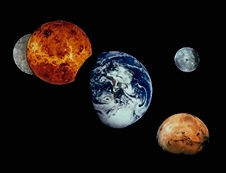| THE NIGHT SKY - SEARCHING FOR
PLANETS There is more
than knowing the order of the planets and their names. The planets of
the Solar system all have their own unique characteristics. You can
group the planets into terrestrial and gaseous planets. Terrestrial
are those inner planets of Mercury, Venus, Earth, and Mars that are
composed mainly of rock. Pluto is also a terrestrial planet, but it is
part of the outer planets.
Jupiter, Saturn, Neptune, and
Uranus are considered the gas giants. They are thousands of times
larger than the terrestrial planets. Their surface is composed of tens
of thousands of kilometers of a sea of liquid gaseous material. Letís
look at how ancient people first started to see the difference between
a star and a planet. Then we will compare and contrast each of the
planets and their associated moons.
Look at the following
pictures and see if you can tell what is wrong with each
picture.
|

Terrestrial Planets

Gas Planets |